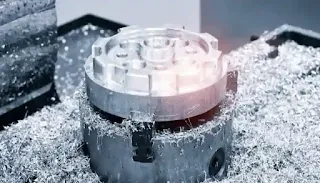The whispers of an industrial revolution, where machines reshaped our world, are not unfamiliar. From steam engines to the birth of automation, every industrial leap has invariably altered our way of life. Central to this paradigm shift in recent years is CNC Machining, a marvel that stands as a testament to human ingenuity and innovation.
What is CNC Machining?
Computer Numerical Control (CNC) Machining is a process utilized in the manufacturing sector, where computers command tools to create a product or part. Unlike the hands-on crafting approach, CNC machining uses digital plans and cutting-edge software.
While traditional machining relies heavily on
manual operation, CNC machining reduces human intervention, making it both
accurate and efficient. Simply put, where traditional methods falter in
precision, CNC triumphs.
Key Components of CNC Machines
At the heart of this technological marvel are
several integral components, each playing its pivotal role.
Basic Structure
Controller: This is the brain, where the computer commands are stored and
executed.
Machine
Interface: The conduit between the controller and the
machine.
Drive
Motors: These powerhouses move and control the
machinery.
Feedback
System: A system that ensures the machine's actions
align with the controller's commands.
Machine
Tool: The piece that interacts with the product,
cutting and shaping as needed.
Software Wonders: CAD & CAM
CNC isn't just about the physical machine;
it's also about the software. CAD (Computer-Aided Design) assists in creating
detailed 3D models, while CAM (Computer-Aided Manufacturing) aids in the
production process, translating the designs into precise machine instructions.
Benefits of CNC Machining
The advantages of CNC Machining are profound
and have rippled across industries, marking new eras of production and design.
Precision & Accuracy
Every industry values precision. With CNC's
ability to follow exact digital blueprints, products come out with remarkable
accuracy, down to the minutest detail.
Repeatability
Imagine producing thousands of parts, each
echoing the perfection of the last. This level of consistency is what CNC
promises and delivers.
Complexity & Flexibility
Intricate designs, once deemed impossible or
labor-intensive, are now in reach, all thanks to the flexibility and
capabilities of CNC machines.
Reduced Manual Labor & Errors
With automation at the forefront, the scope
for human errors dwindles, ensuring a higher yield of flawless products.
According to CNCFirst,
a CNC machining prototyping factory in China, they require few employees
compared to other kinds of categories because of their automation system.
Economic Perks
Time is money. With its efficiency, CNC
machining not only speeds up production but also stands as a cost-effective
solution in the long haul.
How CNC Machining is Transforming Industries: An In-depth Analysis
The ubiquity of CNC machining's influence
extends across industries, offering unparalleled advantages and paving the way
for advancements that were once thought impossible. According to a CNC
manufacturing factory Machining Today, from aerospace to small
plastic toys, this technology is best for efficiency and accuracy. From
crafting intricate pieces of art to fortifying our defense systems, here’s a
deeper dive into how CNC machining has embedded itself at the heart of modern
industries:
1. Aerospace & Defense
In an industry where every millimeter and
millisecond counts, CNC machining has risen as an irreplaceable asset.
Aerospace components are often complex, needing to withstand extreme
conditions. Through CNC:
●
High-Precision: Parts like turbine blades,
engine parts, and structural components are crafted to exact specifications.
●
Material Versatility: CNC machines can handle
tough-to-machine materials like titanium, used frequently in aerospace for its
strength-to-weight ratio.
●
Safety and Compliance: With precision comes
enhanced safety, ensuring every aircraft component complies with stringent
international standards.
Healthcare
The integration of CNC technology in
healthcare has been nothing short of transformative:
●
Customized Solutions: From dental implants to
orthopedic joints, CNC allows for patient-specific solutions.
●
Advanced Surgical Tools: Surgeons now have
access to tools made with extreme precision, enhancing surgical outcomes.
●
Biocompatible Materials: CNC machines handle
biocompatible materials, ensuring implants and tools don't adversely react
inside the human body.
Automotive
The automotive industry's evolution is
intrinsically linked with technological advancements, and CNC machining stands
out:
●
Rapid Prototyping: Before full-scale
production, car parts are prototyped. CNC speeds up this process, allowing for
quicker design iterations.
●
Enhanced Performance: High-precision
components lead to better engine efficiency and vehicle performance.
●
Economical Mass Production: Once a design is
finalized, CNC machines can produce large quantities without sacrificing
quality.
Construction
While construction may seem an unlikely
candidate for CNC's finesse, the synergy is evident:
●
Tool Manufacturing: Precision tools,
especially for detailed architectural work, are now possible.
●
Modular Components: For structures that
incorporate modular designs, CNC ensures each module fits seamlessly with the
next.
●
Durable Materials: By handling a variety of
materials, CNC machines create components that stand the test of time, weather,
and stress.
Consumer Electronics
In our digital age, the demand for smaller,
more efficient devices is ever-growing:
●
Miniaturization: As devices shrink, the need
for minute, precise components grows. CNC delivers with unparalleled accuracy.
●
Heat Dissipation Components: The efficiency of
electronic devices often hinges on heat dissipation. CNC machines craft
intricate heat sinks and other thermal components.
●
Durable Casings: Protecting the delicate
internals of our devices requires precise casings, often crafted using CNC.
Art and Jewelry
The realm of artistry and jewelry-making has
seen a renaissance with CNC:
Detailed
Craftsmanship: Artists can now realize intricate
designs that were once too complex for handcrafting.
Material
Diversity: From precious metals to gemstones, CNC
machines handle a spectrum of materials, offering artists a broader canvas.
Consistent
Reproductions: For artists producing limited edition
pieces, CNC ensures each piece mirrors the original in detail.
Environmental Impact
Reduction in Waste
By following exact measures, CNC ensures
minimal wastage of materials, endorsing a more sustainable production method.
Energy Efficiency
Modern CNC machines, while powerful,
prioritize energy conservation, making them environmentally friendly.
However, every coin has two sides. Challenges
like noise pollution, managing coolant wastes, and material disposal still need
addressing.
The Future of CNC Machining and Industry 4.0
Artificial Intelligence, Machine Learning, and
the ever-evolving tech sphere are poised to further amplify CNC's prowess.
Collaborative robots or "cobots" might soon work alongside CNC
machines, while the tussle between Additive Manufacturing (3D Printing) and CNC
Machining presents a fascinating horizon for the manufacturing domain.
Precautions and Maintenance
Regular check-ups ensure CNC machines operate
at peak efficiency. Furthermore, safety can't be stressed enough. Operators
must always adhere to safety guidelines to avoid accidents and ensure smooth
operations.
FAQs
What is
the main difference between CNC and traditional machining?
CNC relies on computer commands and reduces
manual intervention, while traditional methods are more hands-on.
Which
industries benefit the most from CNC machining?
Aerospace, healthcare, automotive,
construction, electronics, and even art and jewelry have been transformed by
CNC machining.
Is CNC
machining environmentally friendly?
Yes, in many ways, especially with reduced
material waste and energy efficiency. However, certain challenges, like coolant
disposal, need addressing.
How
does CNC ensure precision in products?
CNC follows digital blueprints to the tee,
ensuring products are crafted with utmost precision and accuracy.
Conclusion
From redefining precision to revolutionizing
entire industries, CNC machining stands tall as a pillar of modern-day
manufacturing. Its transformative impact is undeniable, and as technology
evolves, CNC's role will only amplify.










0 Comments